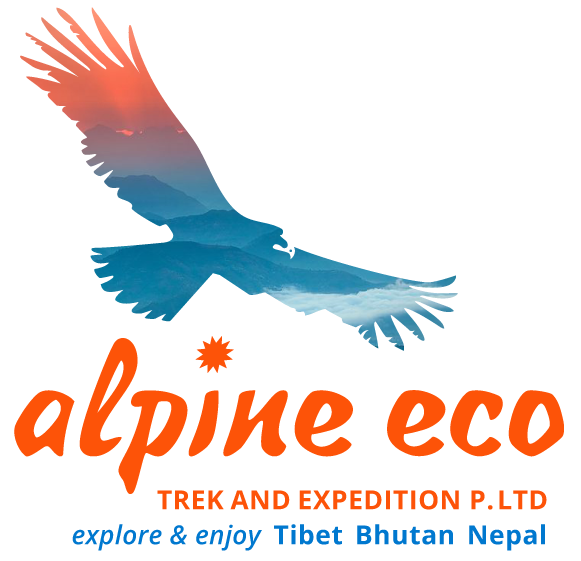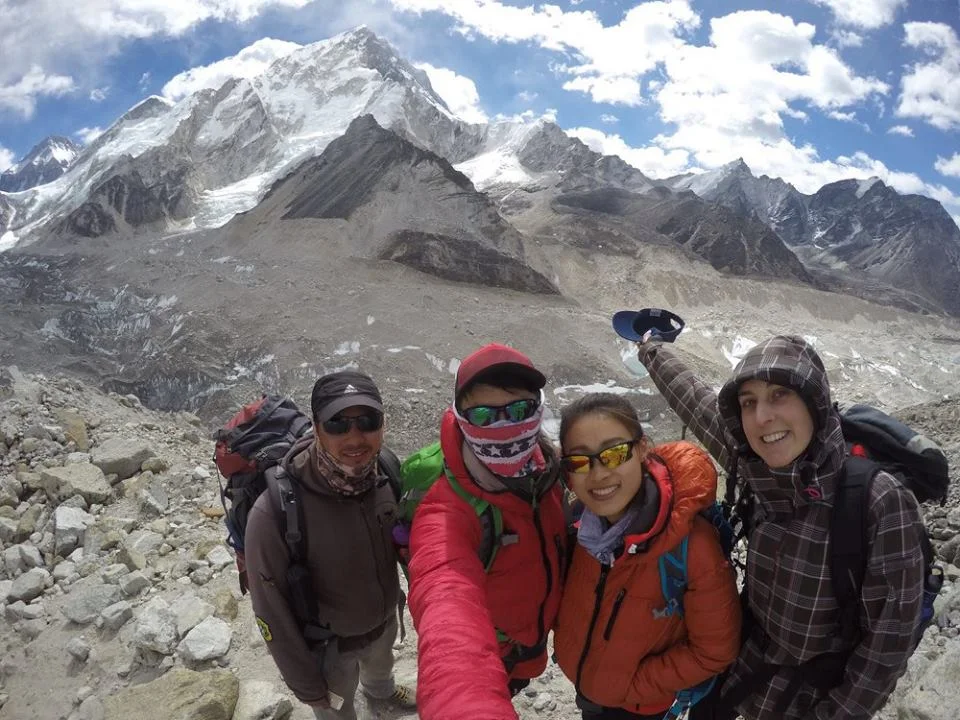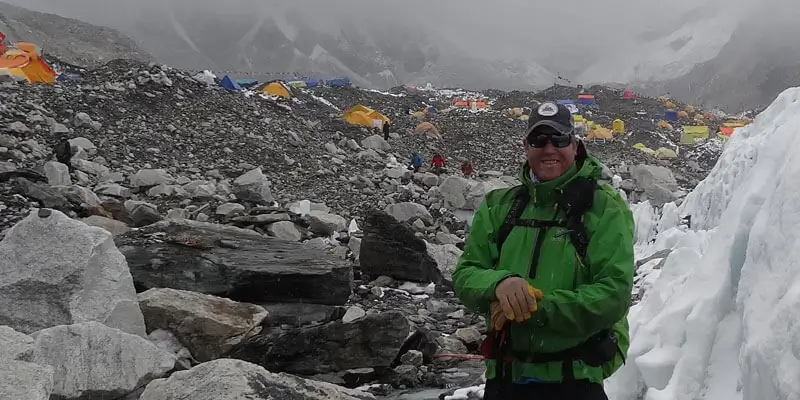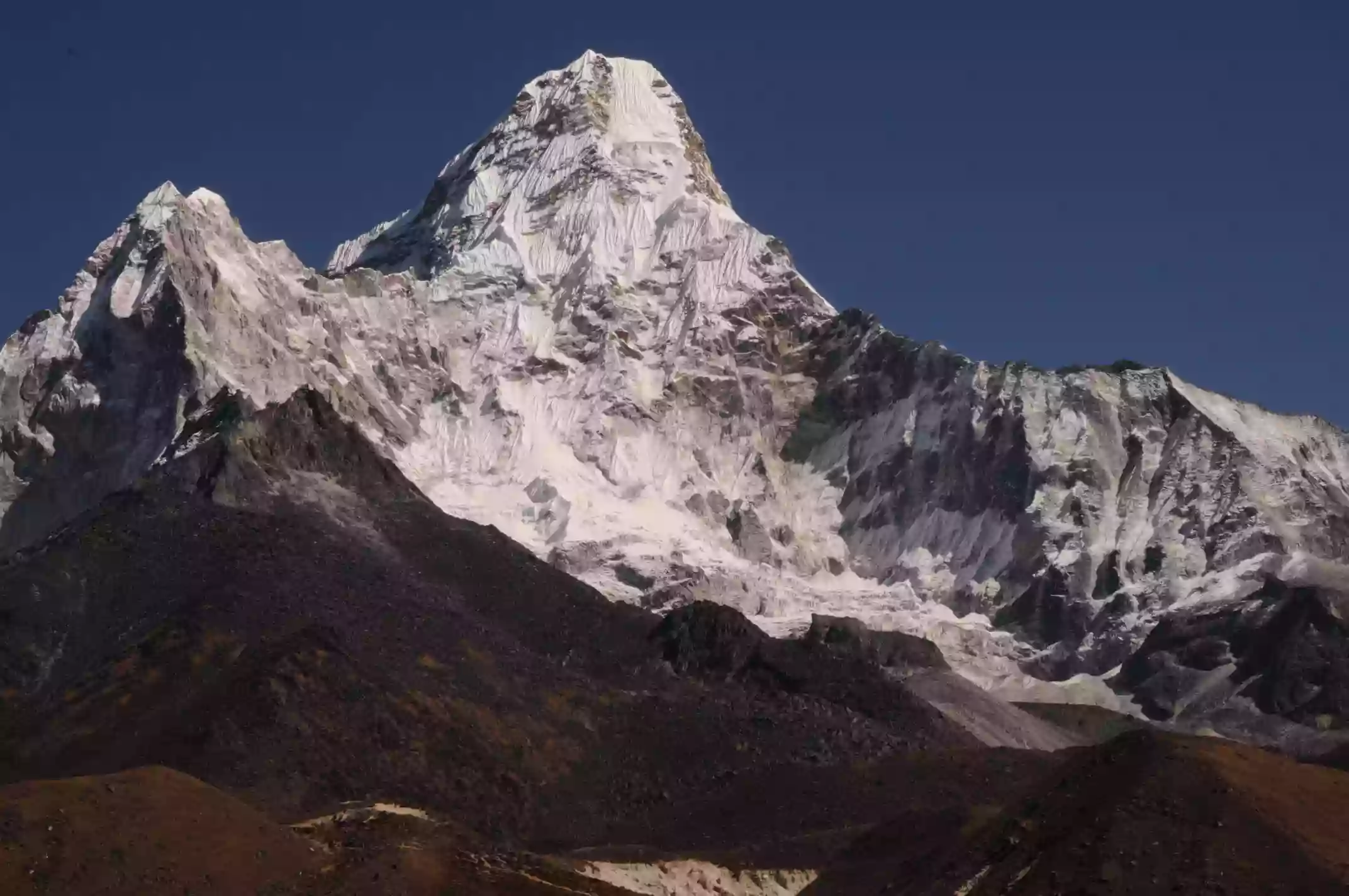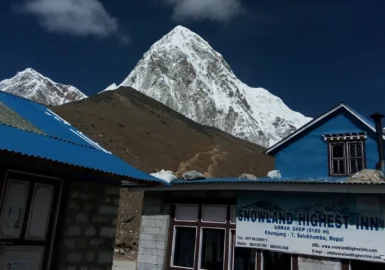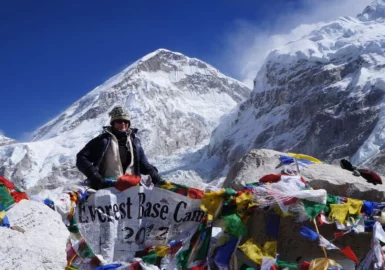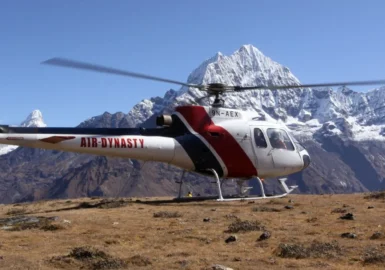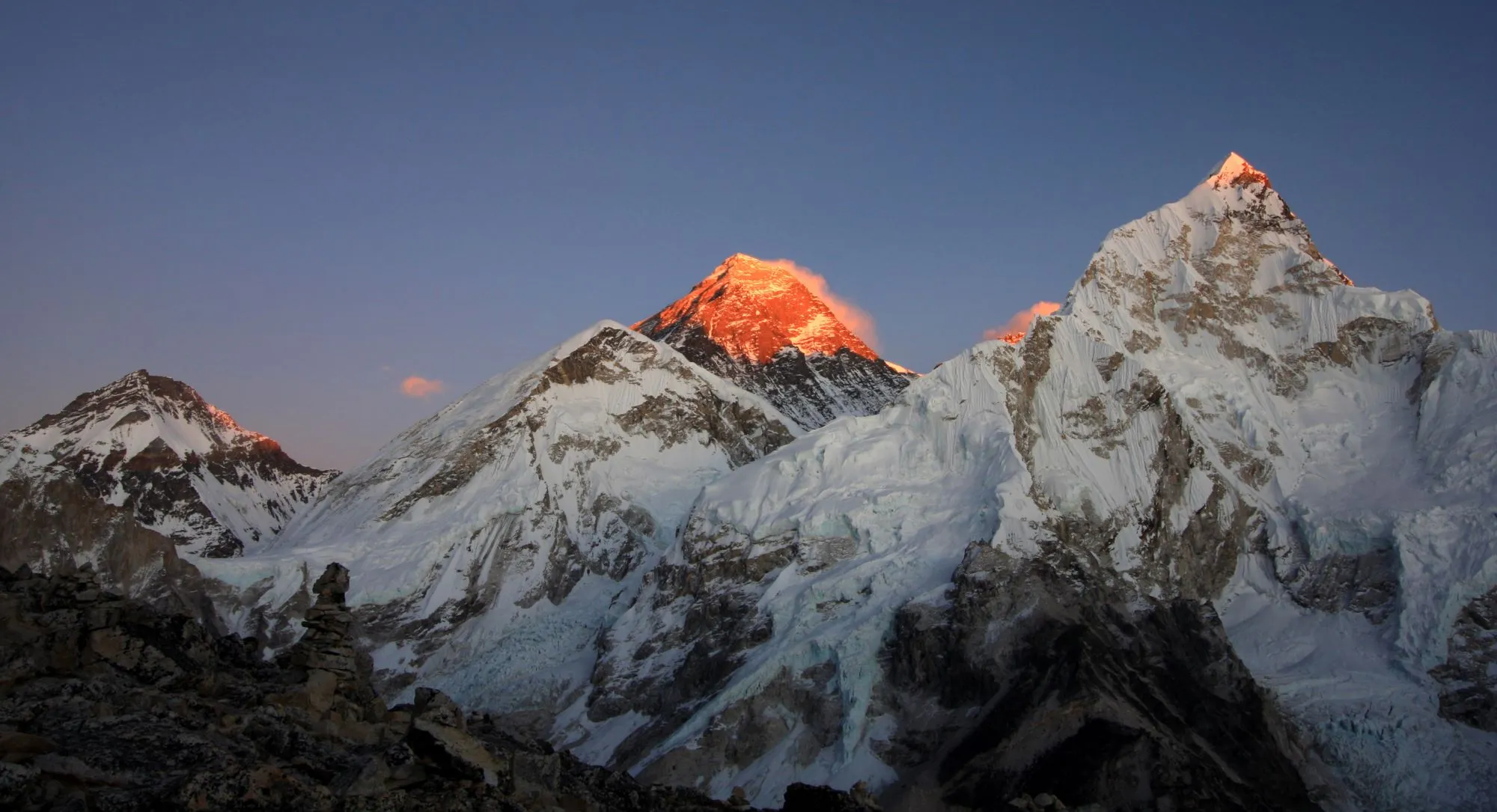
-
Duration :13 Days
-
Group :Min 01 to Max 20
13 Days Everest Base Camp Trek Trip Fact
-
Trip Style : Trekking & Nature Exploration
-
Trip Difficulty : Moderate Hiking
-
Trip Guide : Guided Trek
-
 Destination : Everest Base Camp, Nepal
Destination : Everest Base Camp, Nepal -
 Max Altitude : 5,550 Meters (18,208Ft)
Max Altitude : 5,550 Meters (18,208Ft) -
Daily Walking Hours : 6-7 Hours Walking
-
 Accomodation: Hotels & Lodges
Accomodation: Hotels & Lodges -
 Food : Breakfast, Lunch & Dinner
Food : Breakfast, Lunch & Dinner -
Start-End : Kathmandu / Lukla / Kathmandu
-
Transport : Flight & Car/Van/Bus
-
Best Season : February to June & September to December
13 Days Everest Base Camp Trek Overview
13 days Everest Base Camp trek is one of the most popular and famous trekking holidays in the Everest region (Khumbu). The challenging and strenuous trek that goes through the Everest National Park offers magnificent views of high mountains, unique Sherpa culture, colorful markets, and monumental landscapes.
While doing the EBC trek for 13 days, trekkers can visit some of the most popular monasteries situated at the highest place in the world. During the trek, the time views are stunning and the loyalty and friendliness of the Sherpa people are the highlights of the trip.
You can start the trek with a scenic flight from Kathmandu to Lukla which is a 35-minute mountain flight over the astounding green hills and white snow-capped mountains. This is a tiny airstrip that offers a view of beautiful landscapes and stunning Himalayan giants from where your adventure trek really begins.
Upon your arrival at the Lukla airport, our guide Sherpa crew will already be present to welcome you with a hearty and hospitable gesture. The guide who will accompany you all the way from Lukla will be well-trained, friendly, reliable, and experienced to inform and help you in case of high-altitude sickness.
The trek begins with the normal flat, downhill and uphill hike to the hustling and bustling city of Namche Bazaar. The trekkers will be given two nights to acclimatize to the elevation and atmosphere of the mountains. Namche is an amphitheater-style of town that is the heartland of the Sherpa Kingdom. We can find most of the modern facilities such as Internet cafes, ATMs, bakeries, night bars and gear shops for buying or renting the gear which is used for the Everest base camp trek of 13 days.
After adapting to an elevation in Namche, we start our trek towards the beautiful Everest base camp. The journey begins with the first glimpse of the exotic view of Himalayan giants which includes Mt. Everest, Mt. Lhotse, Mt. Ama Dablam, Mt. Thamserku, and Mt. Pumori.
After witnessing the stunning mountain ranges, we move forward to our next destination, Tengboche. Tengboche gives trekkers an opportunity to explore the world-famous Tengboche monastery which holds an outstanding history. The following day, we trek to Pheriche, where we accommodate for two nights to have a good rest and gather strength for our upcoming journey. In Pheriche, we will hike up to 5000 m and spend the night at an elevation of 4200m.
Experts say that hiking at a higher elevation and sleeping at a lower elevation altitude help moderate altitude sickness. Therefore, we follow the same method and complete the Everest base camp trekking with ease.
The trek continues to Luboche and Gorakshep. These places are over 5000 m which apparently is an elevation prone to triggering altitude sickness. The trekkers might feel a slight headache, shortness of breath and loss of appetite, which are normal symptoms to face in high-altitude areas.
Furthermore, we discover more stunning views of the awe-inspiring mountains such as Mt. Everest, Mt. Lhotse and Mt. Nuptse on our journey back to Lukla from the Everest base camp and Kalapatthar.
Why 13 days Everest Base Camp Trek with Locals?
Hiring a local Trekking Agency for Everest Base Camp hiking holidays is one of the most hassle-free ways to do the trip. Granted, doing the EBC Trek solo is also an option, but going solo without a Trekking Agency will take up much of your time in things like arranging flights, and permits, and scouting out suitable accommodations and meals.
Hiring a local Trekking Agency greatly reduces the hassle of conducting necessary services and document preparation by yourself. Instead, the travel agency will prepare all of the services for you, leaving you with time to enjoy the trip without having to worry about anything else. We will take care of permits and of preparing other necessary documents required during the journey. Besides, hiring a local travel agency also includes a guide, which can be of great help during the trip.
Local guides know much more about the region, their culture, and the route as well. They are responsible for taking care of services like transportation, accommodation, and meals for you. Local guides also include the added advantage of knowing the local dialect, which is of immense help and can enhance the trekking experience. Hiring a travel agency is also safer, especially for first-time trekkers.
We take responsibility for dealing with delayed or canceled internal flights. Especially for first-time visitors to Nepal, visiting a foreign land with a different landscape, culture and language can be a bit terrifying and intimidating. Trekking in the Himalayan wilderness all by yourself can be somewhat anxiety-inducing. That is why hiring an experienced travel and trekking agency allows you to feel more comfortable and safe, with the added benefit of getting insights into Nepali culture and understanding the people in the mountains.
Moreover, considering that the chances of AMS occurring varies from one person to the next, and the chance of getting altitude sick while on your own in the mountains can be a very dangerous situation. Simply put, it is better to hire a reputable travel agency while trekking. And, please read our reviews on Trip Advisor for 13 day Khumbu Base Camp trek.
Trip Highlights
- Pre- trek briefing in Kathmandu
- Get a warm sleeping bag (returnable)
- Trek bag from the Company
- Walkthrough the legendary Sherpa villages and Sagarmatha National Park
- Explore the Namche Bazaar and Everest View Hotel
- Visit the Buddhist monastery in Tengboche
- Explore the unique culture and traditions of highlanders
- Enjoy the awe-inspiring view of Mount Everest range from Kalapathar Peak
- Experience an unforgettable hike to Everest base camp, the trip of a lifetime
-
Outline Itinerary
- + Show More
Meet your guide and staff at Lukla Airport, and start an epic journey to EBC from here and the trail continues to Phakding, which takes approximately four hours. On the way, we will witness an outstanding view of Mt Nupla (5,885 m), Mt. KusumKangaru (6,367 m) and Mt. Kwongde range. Overnight at guesthouse in Phakding.
-
 Accommodation: Teahouse/Guesthouse
Accommodation: Teahouse/Guesthouse
-
 Meals: Breakfast, Lunch and Dinner
Meals: Breakfast, Lunch and Dinner
-
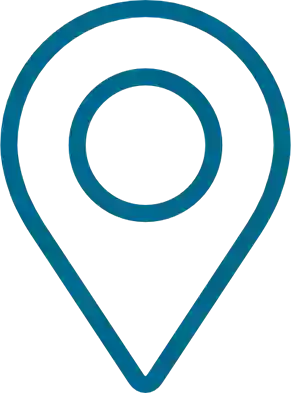 Place: Lukla,Phakding
Place: Lukla,Phakding
-
 Maximum Altitude:2,880 m, 2,640 m
Maximum Altitude:2,880 m, 2,640 m
After a healthy breakfast at the guest house, our adventurous day begins walking through a beautiful trail that passes through scattered villages interspersed with magnificent forest- rhododendron, magnolia trees, and giant firs. On the way, we will be rewarded (weather permitting) by our very first glimpse of Mt. KusumKangru (6369 m), Thamserku (6608 m), Everest (8848 m) and Nuptse (7879 m). In the end, a steep climb up leads us to the beautiful village of Namche Bazaar where we will spend our two nights to gain proper acclimatization. Overnight at guesthouse or hotel in Namche Bazaar.
-
 Accommodation: Teahouse/Guesthouse
Accommodation: Teahouse/Guesthouse
-
 Meals: Breakfast, Lunch and Dinner
Meals: Breakfast, Lunch and Dinner
-
 Place: Namche Bazaar
Place: Namche Bazaar
-
 Maximum Altitude:3,445 m
Maximum Altitude:3,445 m
Acclimatization is the most important part of any trek before proceeding to a higher elevation. However, we do not recommend you to sit idly instead we take a short day hike to Everest view hotel which provides a very close up view of Mt Everest or we can also relax and explore the vibrant town of the Khumbu region itself. Overnight at a hotel or guest house.
-
 Accommodation: Teahouse/Guesthouse
Accommodation: Teahouse/Guesthouse
-
 Meals: Breakfast, Lunch and Dinner
Meals: Breakfast, Lunch and Dinner
-
 Place: Namche
Place: Namche
-
 Maximum Altitude:3,445 m
Maximum Altitude:3,445 m
After walking for about one and a half hour we arrive in Phungithanga. From there the trail climbs through forests where we can spot musk deer. Tengboche sits on a saddle at 3860 m surrounded by dwarf fires and rhododendrons. Mt. Kwongde (6,187 m), Mt. Tawache(6,542 m), Mt. Everest (8848 m), Mt. Nuptse (7,855 m), Mt. Lhotse (8,618 m), Mt. Amadablam (6,856 m) and Mt. Thamserku (6,608 m) provides an awe-inspiring panoramic view of Himalayan giants. We visit the Buddhist Monastery at Tengboche, the largest monastery in the Khumbu region. Overnight at a guest house in Tengboche.
-
 Accommodation: Teahouse/Guesthouse
Accommodation: Teahouse/Guesthouse
-
 Meals: Breakfast, Lunch and Dinner
Meals: Breakfast, Lunch and Dinner
-
 Place: Tengboche
Place: Tengboche
-
 Maximum Altitude:3,860 m
Maximum Altitude:3,860 m
Beyond Tengboche, the altitude really starts to tell. The trail drops down to Deboche, crosses the Imja Khola and climbs past superb mani stones (carved with the Tibetan Buddhist chant ommanipadme hum) to Pangboche at 3,890 m. The Gompa here is worth visiting. Then the trail climbs up to Pheriche at 4,240m above sea level where there is a medical facility, which demonstrates preventive measures and symptoms of Altitude Sickness. Overnight at guest house.
-
 Accommodation: Teahouse/Guesthouse
Accommodation: Teahouse/Guesthouse
-
 Meals: Breakfast, Lunch and Dinner
Meals: Breakfast, Lunch and Dinner
-
 Place: Pheriche
Place: Pheriche
-
 Maximum Altitude:4,240 m
Maximum Altitude:4,240 m
Again keeping your body moving is better than simply resting in high altitudes, so we make a day trip to Nangkartshang Gompa or we walk up the hill to look down onto Dingboche. Either way, the place offers good views of Everest and other surrounding mountains. Overnight at guest house.
-
 Accommodation: Teahouse/Guesthouse
Accommodation: Teahouse/Guesthouse
-
 Meals: Breakfast, Lunch and Dinner
Meals: Breakfast, Lunch and Dinner
-
 Place: Pheriche
Place: Pheriche
-
 Maximum Altitude:4,240 m
Maximum Altitude:4,240 m
From Pheriche to Lobuche, the trail climbs to PhalangKarpo at 4,340 m followed by the trail leading us to Duglha at 4,620 m. From Dughla, the trail ascends the broad, gently sloping valley and climbs steeply into the terminal moraine of the Khumbu glacier leading us towards the memorial area, Chukpilhara, before reaching the Lobuche at 4900 m. Overnight at guest house.
-
 Accommodation: Teahouse/Guesthouse
Accommodation: Teahouse/Guesthouse
-
 Meals: Breakfast, Lunch and Dinner
Meals: Breakfast, Lunch and Dinner
-
 Place: Lobuche
Place: Lobuche
-
 Maximum Altitude:4,900 m
Maximum Altitude:4,900 m
The trail from Lobuche follows the grassy ablation valley with great views of Pumori then crosses tributary glaciers to reach the dry lake bed of Gorak Shep. We stop at Gorak Shep to grab our lunch. From here, we climb the famous Kalapattar to get the best views of Mt. Everest and the surrounding mountains. We then trek back to Gorakshep for the evening. Overnight at a guest house in Gorakshep.
-
 Accommodation: Teahouse/Guesthouse
Accommodation: Teahouse/Guesthouse
-
 Meals: Breakfast, Lunch and Dinner
Meals: Breakfast, Lunch and Dinner
-
 Place: Gorakshep, Kalapatthar
Place: Gorakshep, Kalapatthar
-
 Maximum Altitude:5,150 m, 5,545 m
Maximum Altitude:5,150 m, 5,545 m
Early morning we walk to Everest Base Camp, visit Everest base camp area and trek back down to Lobuche. Overnight at guest house.
-
 Accommodation: Teahouse/Guesthouse
Accommodation: Teahouse/Guesthouse
-
 Meals: Breakfast, Lunch and Dinner
Meals: Breakfast, Lunch and Dinner
-
 Place: Everest Base Camp, Pheriche
Place: Everest Base Camp, Pheriche
-
 Maximum Altitude:5,364m
Maximum Altitude:5,364m
After a healthy breakfast, we start our trek leisurely down to Tengboche enjoying the thin air and stunning views of Himalayan giants. Staying the night at Tengboche makes an interesting accommodation alternative. Overnight at guest house.
-
 Accommodation: Teahouse/Guesthouse
Accommodation: Teahouse/Guesthouse
-
 Meals: Breakfast, Lunch and Dinner
Meals: Breakfast, Lunch and Dinner
-
 Place: Tengboche
Place: Tengboche
-
 Maximum Altitude:3,860m
Maximum Altitude:3,860m
Our pleasant trek starts after a hot and warm breakfast at Tengboche. We will have our lunch for the day at Phungithanga after which our trek to Namche Bazaar continues. Overnight at the hotel in Namche Bazaar.
-
 Accommodation: Hotel/Guesthouse
Accommodation: Hotel/Guesthouse
-
 Meals: Breakfast, Lunch and Dinner
Meals: Breakfast, Lunch and Dinner
-
 Place: Namche Bazaar
Place: Namche Bazaar
-
 Maximum Altitude:3,445m
Maximum Altitude:3,445m
After early morning breakfast, we descend slowly down to Monjo then to Phakding where we will stop to have our lunch. After a delicious lunch, we continue our walk to Lukla. We trek steep up for 45 minutes to reach our destination, Lukla. Overnight at guesthouse or hotel in Lukla.
-
 Accommodation: Hotel/Guesthouse
Accommodation: Hotel/Guesthouse
-
 Meals: Breakfast, Lunch and Dinner
Meals: Breakfast, Lunch and Dinner
-
 Place: Lukla
Place: Lukla
-
 Maximum Altitude:2,880m
Maximum Altitude:2,880m
After breakfast, our service will be end and you can fly to Kathmandu. If you need any assistance please feel free to let us know. We will be glad to assist you.
-
 Accommodation: On your own
Accommodation: On your own
-
 Meals: on your own
Meals: on your own
-
 Place: Kathmandu
Place: Kathmandu
-
 Maximum Altitude:1,350m
Maximum Altitude:1,350m
Map of This Trek
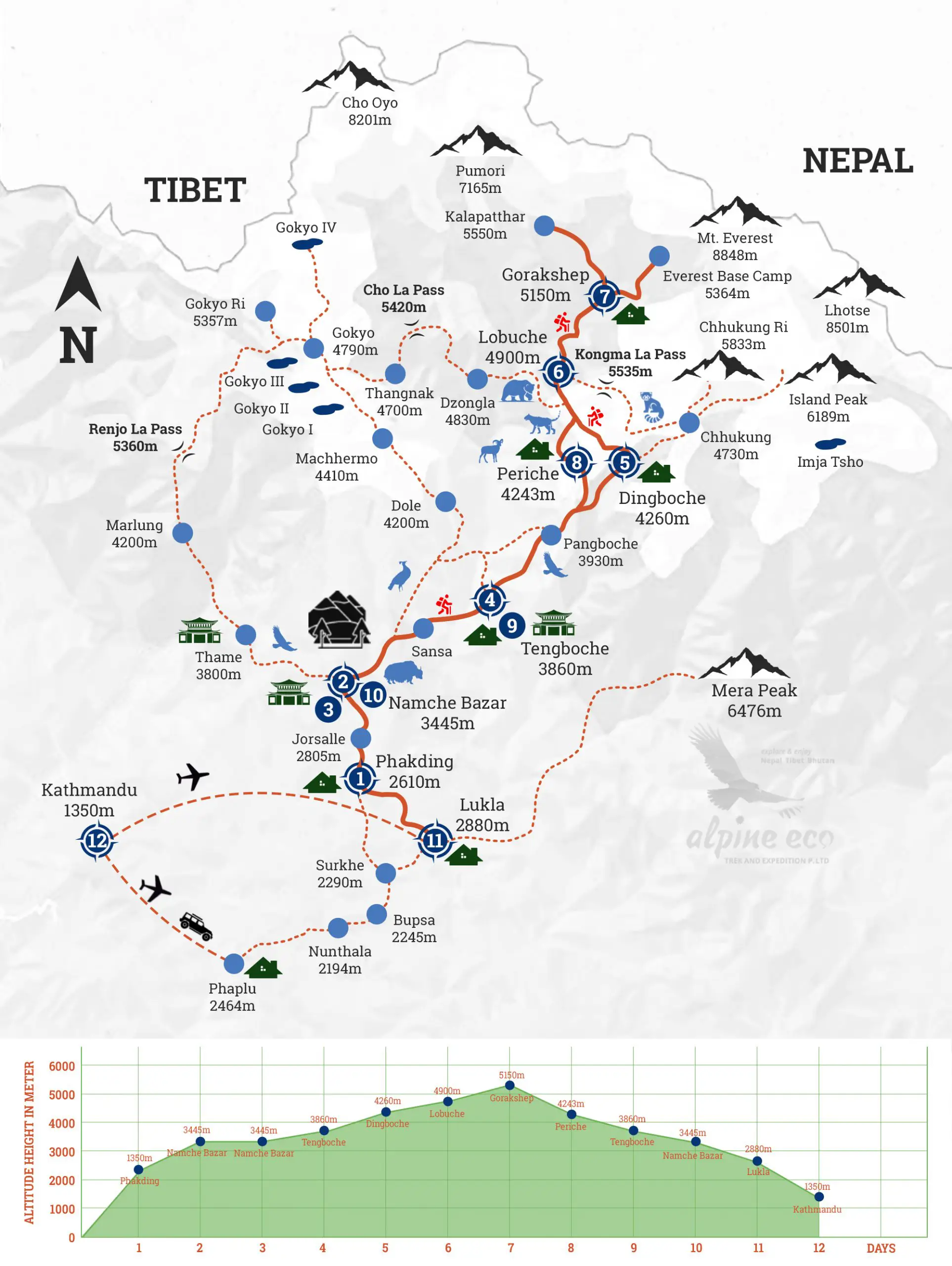
13 Days Everest Base Camp Trek
-
PRICES & DATES
| Start Date | Finish Date | Availability | Price | |
| 13th May, 2024 | 25th May, 2024 | Guaranteed No. of Seats Available 20 | US$ 1050 | Book Now |
| 18th May, 2024 | 30th May, 2024 | Guaranteed No. of Seats Available 20 | US$ 1050 | Book Now |
| 23rd May, 2024 | 4th June, 2024 | Guaranteed No. of Seats Available 20 | US$ 1050 | Book Now |
| 28th May, 2024 | 9th June, 2024 | Guaranteed No. of Seats Available 20 | US$ 1050 | Book Now |
| 2nd June, 2024 | 14th June, 2024 | Guaranteed No. of Seats Available 20 | US$ 1050 | Book Now |
| 7th June, 2024 | 19th June, 2024 | Guaranteed No. of Seats Available 20 | US$ 1050 | Book Now |
| 12th June, 2024 | 24th June, 2024 | Guaranteed No. of Seats Available 20 | US$ 1050 | Book Now |
| 17th June, 2024 | 29th June, 2024 | Guaranteed No. of Seats Available 20 | US$ 1050 | Book Now |
| 22nd June, 2024 | 4th July, 2024 | Guaranteed No. of Seats Available 20 | US$ 1050 | Book Now |
| 27th June, 2024 | 9th July, 2024 | Guaranteed No. of Seats Available 20 | US$ 1050 | Book Now |
| 2nd July, 2024 | 14th July, 2024 | Guaranteed No. of Seats Available 20 | US$ 1050 | Book Now |
| 7th July, 2024 | 19th July, 2024 | Guaranteed No. of Seats Available 20 | US$ 1050 | Book Now |
| 12th July, 2024 | 24th July, 2024 | Guaranteed No. of Seats Available 20 | US$ 1050 | Book Now |
| 17th July, 2024 | 29th July, 2024 | Guaranteed No. of Seats Available 20 | US$ 1050 | Book Now |
| 22nd July, 2024 | 3rd August, 2024 | Guaranteed No. of Seats Available 20 | US$ 1050 | Book Now |
| 27th July, 2024 | 8th August, 2024 | Guaranteed No. of Seats Available 20 | US$ 1050 | Book Now |
| 1st August, 2024 | 13th August, 2024 | Guaranteed No. of Seats Available 20 | US$ 1050 | Book Now |
| 6th August, 2024 | 18th August, 2024 | Guaranteed No. of Seats Available 20 | US$ 1050 | Book Now |
| 11th August, 2024 | 23rd August, 2024 | Guaranteed No. of Seats Available 20 | US$ 1050 | Book Now |
| 16th August, 2024 | 28th August, 2024 | Guaranteed No. of Seats Available 20 | US$ 1050 | Book Now |
| 21st August, 2024 | 2nd September, 2024 | Guaranteed No. of Seats Available 20 | US$ 1050 | Book Now |
| 26th August, 2024 | 7th September, 2024 | Guaranteed No. of Seats Available 20 | US$ 1050 | Book Now |
| 31st August, 2024 | 12th September, 2024 | Guaranteed No. of Seats Available 20 | US$ 1050 | Book Now |
| 5th September, 2024 | 17th September, 2024 | Guaranteed No. of Seats Available 20 | US$ 1050 | Book Now |
| 10th September, 2024 | 22nd September, 2024 | Guaranteed No. of Seats Available 20 | US$ 1050 | Book Now |
| 15th September, 2024 | 27th September, 2024 | Guaranteed No. of Seats Available 20 | US$ 1050 | Book Now |
| 20th September, 2024 | 2nd October, 2024 | Guaranteed No. of Seats Available 20 | US$ 1050 | Book Now |
| 25th September, 2024 | 7th October, 2024 | Guaranteed No. of Seats Available 20 | US$ 1050 | Book Now |
| 30th September, 2024 | 12th October, 2024 | Guaranteed No. of Seats Available 20 | US$ 1050 | Book Now |
| 5th October, 2024 | 17th October, 2024 | Guaranteed No. of Seats Available 20 | US$ 1050 | Book Now |
| 10th October, 2024 | 22nd October, 2024 | Guaranteed No. of Seats Available 20 | US$ 1050 | Book Now |
| 15th October, 2024 | 27th October, 2024 | Guaranteed No. of Seats Available 20 | US$ 1050 | Book Now |
| 20th October, 2024 | 1st November, 2024 | Guaranteed No. of Seats Available 20 | US$ 1050 | Book Now |
| 25th October, 2024 | 6th November, 2024 | Guaranteed No. of Seats Available 20 | US$ 1050 | Book Now |
| 30th October, 2024 | 11th November, 2024 | Guaranteed No. of Seats Available 20 | US$ 1050 | Book Now |
| 4th November, 2024 | 16th November, 2024 | Guaranteed No. of Seats Available 20 | US$ 1050 | Book Now |
| 9th November, 2024 | 21st November, 2024 | Guaranteed No. of Seats Available 20 | US$ 1050 | Book Now |
| 14th November, 2024 | 26th November, 2024 | Guaranteed No. of Seats Available 20 | US$ 1050 | Book Now |
| 19th November, 2024 | 1st December, 2024 | Guaranteed No. of Seats Available 20 | US$ 1050 | Book Now |
| 24th November, 2024 | 6th December, 2024 | Guaranteed No. of Seats Available 20 | US$ 1050 | Book Now |
| 29th November, 2024 | 11th December, 2024 | Guaranteed No. of Seats Available 20 | US$ 1050 | Book Now |
| 4th December, 2024 | 16th December, 2024 | Guaranteed No. of Seats Available 20 | US$ 1050 | Book Now |
| 9th December, 2024 | 21st December, 2024 | Guaranteed No. of Seats Available 20 | US$ 1050 | Book Now |
| 14th December, 2024 | 26th December, 2024 | Guaranteed No. of Seats Available 20 | US$ 1050 | Book Now |
| 19th December, 2024 | 31st December, 2024 | Guaranteed No. of Seats Available 20 | US$ 1050 | Book Now |
| 24th December, 2024 | 5th January, 2025 | Guaranteed No. of Seats Available 20 | US$ 1050 | Book Now |
| 29th December, 2024 | 10th January, 2025 | Guaranteed No. of Seats Available 20 | US$ 1050 | Book Now |
| 3rd January, 2025 | 15th January, 2025 | Guaranteed No. of Seats Available 20 | US$ 1050 | Book Now |
| 8th January, 2025 | 20th January, 2025 | Guaranteed No. of Seats Available 20 | US$ 1050 | Book Now |
| 13th January, 2025 | 25th January, 2025 | Guaranteed No. of Seats Available 20 | US$ 1050 | Book Now |
| 18th January, 2025 | 30th January, 2025 | Guaranteed No. of Seats Available 20 | US$ 1050 | Book Now |
| 23rd January, 2025 | 4th February, 2025 | Guaranteed No. of Seats Available 20 | US$ 1050 | Book Now |
| 28th January, 2025 | 9th February, 2025 | Guaranteed No. of Seats Available 20 | US$ 1050 | Book Now |
| 2nd February, 2025 | 14th February, 2025 | Guaranteed No. of Seats Available 20 | US$ 1050 | Book Now |
| 7th February, 2025 | 19th February, 2025 | Guaranteed No. of Seats Available 20 | US$ 1050 | Book Now |
| 12th February, 2025 | 24th February, 2025 | Guaranteed No. of Seats Available 20 | US$ 1050 | Book Now |
| 17th February, 2025 | 1st March, 2025 | Guaranteed No. of Seats Available 20 | US$ 1050 | Book Now |
| 22nd February, 2025 | 6th March, 2025 | Guaranteed No. of Seats Available 20 | US$ 1050 | Book Now |
| 27th February, 2025 | 11th March, 2025 | Guaranteed No. of Seats Available 20 | US$ 1050 | Book Now |
| 4th March, 2025 | 16th March, 2025 | Guaranteed No. of Seats Available 20 | US$ 1050 | Book Now |
| 9th March, 2025 | 21st March, 2025 | Guaranteed No. of Seats Available 20 | US$ 1050 | Book Now |
| 14th March, 2025 | 26th March, 2025 | Guaranteed No. of Seats Available 20 | US$ 1050 | Book Now |
| 19th March, 2025 | 31st March, 2025 | Guaranteed No. of Seats Available 20 | US$ 1050 | Book Now |
| 24th March, 2025 | 5th April, 2025 | Guaranteed No. of Seats Available 20 | US$ 1050 | Book Now |
| 29th March, 2025 | 10th April, 2025 | Guaranteed No. of Seats Available 20 | US$ 1050 | Book Now |
| 3rd April, 2025 | 15th April, 2025 | Guaranteed No. of Seats Available 20 | US$ 1050 | Book Now |
| 8th April, 2025 | 20th April, 2025 | Guaranteed No. of Seats Available 20 | US$ 1050 | Book Now |
| 13th April, 2025 | 25th April, 2025 | Guaranteed No. of Seats Available 20 | US$ 1050 | Book Now |
| 18th April, 2025 | 30th April, 2025 | Guaranteed No. of Seats Available 20 | US$ 1050 | Book Now |
| 23rd April, 2025 | 5th May, 2025 | Guaranteed No. of Seats Available 20 | US$ 1050 | Book Now |
| 28th April, 2025 | 10th May, 2025 | Guaranteed No. of Seats Available 20 | US$ 1050 | Book Now |
| 3rd May, 2025 | 15th May, 2025 | Guaranteed No. of Seats Available 20 | US$ 1050 | Book Now |
| 8th May, 2025 | 20th May, 2025 | Guaranteed No. of Seats Available 20 | US$ 1050 | Book Now |
| 13th May, 2025 | 25th May, 2025 | Guaranteed No. of Seats Available 20 | US$ 1050 | Book Now |
| 18th May, 2025 | 30th May, 2025 | Guaranteed No. of Seats Available 20 | US$ 1050 | Book Now |
| 23rd May, 2025 | 4th June, 2025 | Guaranteed No. of Seats Available 20 | US$ 1050 | Book Now |
| 28th May, 2025 | 9th June, 2025 | Guaranteed No. of Seats Available 20 | US$ 1050 | Book Now |
| 2nd June, 2025 | 14th June, 2025 | Guaranteed No. of Seats Available 20 | US$ 1050 | Book Now |
| 7th June, 2025 | 19th June, 2025 | Guaranteed No. of Seats Available 20 | US$ 1050 | Book Now |
| 12th June, 2025 | 24th June, 2025 | Guaranteed No. of Seats Available 20 | US$ 1050 | Book Now |
| 17th June, 2025 | 29th June, 2025 | Guaranteed No. of Seats Available 20 | US$ 1050 | Book Now |
| 22nd June, 2025 | 4th July, 2025 | Guaranteed No. of Seats Available 20 | US$ 1050 | Book Now |
| 27th June, 2025 | 9th July, 2025 | Guaranteed No. of Seats Available 20 | US$ 1050 | Book Now |
| 2nd July, 2025 | 14th July, 2025 | Guaranteed No. of Seats Available 20 | US$ 1050 | Book Now |
| 7th July, 2025 | 19th July, 2025 | Guaranteed No. of Seats Available 20 | US$ 1050 | Book Now |
| 12th July, 2025 | 24th July, 2025 | Guaranteed No. of Seats Available 20 | US$ 1050 | Book Now |
| 17th July, 2025 | 29th July, 2025 | Guaranteed No. of Seats Available 20 | US$ 1050 | Book Now |
| 22nd July, 2025 | 3rd August, 2025 | Guaranteed No. of Seats Available 20 | US$ 1050 | Book Now |
| 27th July, 2025 | 8th August, 2025 | Guaranteed No. of Seats Available 20 | US$ 1050 | Book Now |
| 1st August, 2025 | 13th August, 2025 | Guaranteed No. of Seats Available 20 | US$ 1050 | Book Now |
| 6th August, 2025 | 18th August, 2025 | Guaranteed No. of Seats Available 20 | US$ 1050 | Book Now |
| 11th August, 2025 | 23rd August, 2025 | Guaranteed No. of Seats Available 20 | US$ 1050 | Book Now |
| 16th August, 2025 | 28th August, 2025 | Guaranteed No. of Seats Available 20 | US$ 1050 | Book Now |
| 21st August, 2025 | 2nd September, 2025 | Guaranteed No. of Seats Available 20 | US$ 1050 | Book Now |
| 26th August, 2025 | 7th September, 2025 | Guaranteed No. of Seats Available 20 | US$ 1050 | Book Now |
| 31st August, 2025 | 12th September, 2025 | Guaranteed No. of Seats Available 20 | US$ 1050 | Book Now |
| 5th September, 2025 | 17th September, 2025 | Guaranteed No. of Seats Available 20 | US$ 1050 | Book Now |
| 10th September, 2025 | 22nd September, 2025 | Guaranteed No. of Seats Available 20 | US$ 1050 | Book Now |
| 15th September, 2025 | 27th September, 2025 | Guaranteed No. of Seats Available 20 | US$ 1050 | Book Now |
| 20th September, 2025 | 2nd October, 2025 | Guaranteed No. of Seats Available 20 | US$ 1050 | Book Now |
| 25th September, 2025 | 7th October, 2025 | Guaranteed No. of Seats Available 20 | US$ 1050 | Book Now |
| 30th September, 2025 | 12th October, 2025 | Guaranteed No. of Seats Available 20 | US$ 1050 | Book Now |
| 5th October, 2025 | 17th October, 2025 | Guaranteed No. of Seats Available 20 | US$ 1050 | Book Now |
| 10th October, 2025 | 22nd October, 2025 | Guaranteed No. of Seats Available 20 | US$ 1050 | Book Now |
| 15th October, 2025 | 27th October, 2025 | Guaranteed No. of Seats Available 20 | US$ 1050 | Book Now |
| 20th October, 2025 | 1st November, 2025 | Guaranteed No. of Seats Available 20 | US$ 1050 | Book Now |
| 25th October, 2025 | 6th November, 2025 | Guaranteed No. of Seats Available 20 | US$ 1050 | Book Now |
| 30th October, 2025 | 11th November, 2025 | Guaranteed No. of Seats Available 20 | US$ 1050 | Book Now |
| 4th November, 2025 | 16th November, 2025 | Guaranteed No. of Seats Available 20 | US$ 1050 | Book Now |
| 9th November, 2025 | 21st November, 2025 | Guaranteed No. of Seats Available 20 | US$ 1050 | Book Now |
| 14th November, 2025 | 26th November, 2025 | Guaranteed No. of Seats Available 20 | US$ 1050 | Book Now |
| 19th November, 2025 | 1st December, 2025 | Guaranteed No. of Seats Available 20 | US$ 1050 | Book Now |
| 24th November, 2025 | 6th December, 2025 | Guaranteed No. of Seats Available 20 | US$ 1050 | Book Now |
| 29th November, 2025 | 11th December, 2025 | Guaranteed No. of Seats Available 20 | US$ 1050 | Book Now |
| 4th December, 2025 | 16th December, 2025 | Guaranteed No. of Seats Available 20 | US$ 1050 | Book Now |
| 9th December, 2025 | 21st December, 2025 | Guaranteed No. of Seats Available 20 | US$ 1050 | Book Now |
| 14th December, 2025 | 26th December, 2025 | Guaranteed No. of Seats Available 20 | US$ 1050 | Book Now |
| 19th December, 2025 | 31st December, 2025 | Guaranteed No. of Seats Available 20 | US$ 1050 | Book Now |
| 24th December, 2025 | 5th January, 2026 | Guaranteed No. of Seats Available 20 | US$ 1050 | Book Now |
| 29th December, 2025 | 10th January, 2026 | Guaranteed No. of Seats Available 20 | US$ 1050 | Book Now |
| 3rd January, 2026 | 15th January, 2026 | Guaranteed No. of Seats Available 20 | US$ 1050 | Book Now |
| 8th January, 2026 | 20th January, 2026 | Guaranteed No. of Seats Available 20 | US$ 1050 | Book Now |
| 13th January, 2026 | 25th January, 2026 | Guaranteed No. of Seats Available 20 | US$ 1050 | Book Now |
| 18th January, 2026 | 30th January, 2026 | Guaranteed No. of Seats Available 20 | US$ 1050 | Book Now |
| 23rd January, 2026 | 4th February, 2026 | Guaranteed No. of Seats Available 20 | US$ 1050 | Book Now |
| 28th January, 2026 | 9th February, 2026 | Guaranteed No. of Seats Available 20 | US$ 1050 | Book Now |
| 2nd February, 2026 | 14th February, 2026 | Guaranteed No. of Seats Available 20 | US$ 1050 | Book Now |
| 7th February, 2026 | 19th February, 2026 | Guaranteed No. of Seats Available 20 | US$ 1050 | Book Now |
| 12th February, 2026 | 24th February, 2026 | Guaranteed No. of Seats Available 20 | US$ 1050 | Book Now |
| 17th February, 2026 | 1st March, 2026 | Guaranteed No. of Seats Available 20 | US$ 1050 | Book Now |
| 22nd February, 2026 | 6th March, 2026 | Guaranteed No. of Seats Available 20 | US$ 1050 | Book Now |
| 27th February, 2026 | 11th March, 2026 | Guaranteed No. of Seats Available 20 | US$ 1050 | Book Now |
| 4th March, 2026 | 16th March, 2026 | Guaranteed No. of Seats Available 20 | US$ 1050 | Book Now |
| 9th March, 2026 | 21st March, 2026 | Guaranteed No. of Seats Available 20 | US$ 1050 | Book Now |
| 14th March, 2026 | 26th March, 2026 | Guaranteed No. of Seats Available 20 | US$ 1050 | Book Now |
| 19th March, 2026 | 31st March, 2026 | Guaranteed No. of Seats Available 20 | US$ 1050 | Book Now |
| 24th March, 2026 | 5th April, 2026 | Guaranteed No. of Seats Available 20 | US$ 1050 | Book Now |
| 29th March, 2026 | 10th April, 2026 | Guaranteed No. of Seats Available 20 | US$ 1050 | Book Now |
| 3rd April, 2026 | 15th April, 2026 | Guaranteed No. of Seats Available 20 | US$ 1050 | Book Now |
| 8th April, 2026 | 20th April, 2026 | Guaranteed No. of Seats Available 20 | US$ 1050 | Book Now |
| 13th April, 2026 | 25th April, 2026 | Guaranteed No. of Seats Available 20 | US$ 1050 | Book Now |
| 18th April, 2026 | 30th April, 2026 | Guaranteed No. of Seats Available 20 | US$ 1050 | Book Now |
| 23rd April, 2026 | 5th May, 2026 | Guaranteed No. of Seats Available 20 | US$ 1050 | Book Now |
| 28th April, 2026 | 10th May, 2026 | Guaranteed No. of Seats Available 20 | US$ 1050 | Book Now |
| 3rd May, 2026 | 15th May, 2026 | Guaranteed No. of Seats Available 20 | US$ 1050 | Book Now |
| 8th May, 2026 | 20th May, 2026 | Guaranteed No. of Seats Available 20 | US$ 1050 | Book Now |
| 13th May, 2026 | 25th May, 2026 | Guaranteed No. of Seats Available 20 | US$ 1050 | Book Now |
| 18th May, 2026 | 30th May, 2026 | Guaranteed No. of Seats Available 20 | US$ 1050 | Book Now |
| 23rd May, 2026 | 4th June, 2026 | Guaranteed No. of Seats Available 20 | US$ 1050 | Book Now |
| 28th May, 2026 | 9th June, 2026 | Guaranteed No. of Seats Available 20 | US$ 1050 | Book Now |
| 2nd June, 2026 | 14th June, 2026 | Guaranteed No. of Seats Available 20 | US$ 1050 | Book Now |
| 7th June, 2026 | 19th June, 2026 | Guaranteed No. of Seats Available 20 | US$ 1050 | Book Now |
| 12th June, 2026 | 24th June, 2026 | Guaranteed No. of Seats Available 20 | US$ 1050 | Book Now |
| 17th June, 2026 | 29th June, 2026 | Guaranteed No. of Seats Available 20 | US$ 1050 | Book Now |
| 22nd June, 2026 | 4th July, 2026 | Guaranteed No. of Seats Available 20 | US$ 1050 | Book Now |
| 27th June, 2026 | 9th July, 2026 | Guaranteed No. of Seats Available 20 | US$ 1050 | Book Now |
| 2nd July, 2026 | 14th July, 2026 | Guaranteed No. of Seats Available 20 | US$ 1050 | Book Now |
| 7th July, 2026 | 19th July, 2026 | Guaranteed No. of Seats Available 20 | US$ 1050 | Book Now |
| 12th July, 2026 | 24th July, 2026 | Guaranteed No. of Seats Available 20 | US$ 1050 | Book Now |
| 17th July, 2026 | 29th July, 2026 | Guaranteed No. of Seats Available 20 | US$ 1050 | Book Now |
| 22nd July, 2026 | 3rd August, 2026 | Guaranteed No. of Seats Available 20 | US$ 1050 | Book Now |
| 27th July, 2026 | 8th August, 2026 | Guaranteed No. of Seats Available 20 | US$ 1050 | Book Now |
| 1st August, 2026 | 13th August, 2026 | Guaranteed No. of Seats Available 20 | US$ 1050 | Book Now |
| 6th August, 2026 | 18th August, 2026 | Guaranteed No. of Seats Available 20 | US$ 1050 | Book Now |
| 11th August, 2026 | 23rd August, 2026 | Guaranteed No. of Seats Available 20 | US$ 1050 | Book Now |
| 16th August, 2026 | 28th August, 2026 | Guaranteed No. of Seats Available 20 | US$ 1050 | Book Now |
| 21st August, 2026 | 2nd September, 2026 | Guaranteed No. of Seats Available 20 | US$ 1050 | Book Now |
| 26th August, 2026 | 7th September, 2026 | Guaranteed No. of Seats Available 20 | US$ 1050 | Book Now |
| 31st August, 2026 | 12th September, 2026 | Guaranteed No. of Seats Available 20 | US$ 1050 | Book Now |
| 5th September, 2026 | 17th September, 2026 | Guaranteed No. of Seats Available 20 | US$ 1050 | Book Now |
| 10th September, 2026 | 22nd September, 2026 | Guaranteed No. of Seats Available 20 | US$ 1050 | Book Now |
| 15th September, 2026 | 27th September, 2026 | Guaranteed No. of Seats Available 20 | US$ 1050 | Book Now |
| 20th September, 2026 | 2nd October, 2026 | Guaranteed No. of Seats Available 20 | US$ 1050 | Book Now |
| 25th September, 2026 | 7th October, 2026 | Guaranteed No. of Seats Available 20 | US$ 1050 | Book Now |
| 30th September, 2026 | 12th October, 2026 | Guaranteed No. of Seats Available 20 | US$ 1050 | Book Now |
| 5th October, 2026 | 17th October, 2026 | Guaranteed No. of Seats Available 20 | US$ 1050 | Book Now |
| 10th October, 2026 | 22nd October, 2026 | Guaranteed No. of Seats Available 20 | US$ 1050 | Book Now |
| 15th October, 2026 | 27th October, 2026 | Guaranteed No. of Seats Available 20 | US$ 1050 | Book Now |
| 20th October, 2026 | 1st November, 2026 | Guaranteed No. of Seats Available 20 | US$ 1050 | Book Now |
| 25th October, 2026 | 6th November, 2026 | Guaranteed No. of Seats Available 20 | US$ 1050 | Book Now |
| 30th October, 2026 | 11th November, 2026 | Guaranteed No. of Seats Available 20 | US$ 1050 | Book Now |
| 4th November, 2026 | 16th November, 2026 | Guaranteed No. of Seats Available 20 | US$ 1050 | Book Now |
| 9th November, 2026 | 21st November, 2026 | Guaranteed No. of Seats Available 20 | US$ 1050 | Book Now |
| 14th November, 2026 | 26th November, 2026 | Guaranteed No. of Seats Available 20 | US$ 1050 | Book Now |
| 19th November, 2026 | 1st December, 2026 | Guaranteed No. of Seats Available 20 | US$ 1050 | Book Now |
| 24th November, 2026 | 6th December, 2026 | Guaranteed No. of Seats Available 20 | US$ 1050 | Book Now |
| 29th November, 2026 | 11th December, 2026 | Guaranteed No. of Seats Available 20 | US$ 1050 | Book Now |
| 4th December, 2026 | 16th December, 2026 | Guaranteed No. of Seats Available 20 | US$ 1050 | Book Now |
| 9th December, 2026 | 21st December, 2026 | Guaranteed No. of Seats Available 20 | US$ 1050 | Book Now |
| 14th December, 2026 | 26th December, 2026 | Guaranteed No. of Seats Available 20 | US$ 1050 | Book Now |
| 19th December, 2026 | 31st December, 2026 | Guaranteed No. of Seats Available 20 | US$ 1050 | Book Now |
| 24th December, 2026 | 5th January, 2027 | Guaranteed No. of Seats Available 20 | US$ 1050 | Book Now |
| 29th December, 2026 | 10th January, 2027 | Guaranteed No. of Seats Available 20 | US$ 1050 | Book Now |
| 3rd January, 2027 | 15th January, 2027 | Guaranteed No. of Seats Available 20 | US$ 1050 | Book Now |
| 8th January, 2027 | 20th January, 2027 | Guaranteed No. of Seats Available 20 | US$ 1050 | Book Now |
| 13th January, 2027 | 25th January, 2027 | Guaranteed No. of Seats Available 20 | US$ 1050 | Book Now |
| 18th January, 2027 | 30th January, 2027 | Guaranteed No. of Seats Available 20 | US$ 1050 | Book Now |
| 23rd January, 2027 | 4th February, 2027 | Guaranteed No. of Seats Available 20 | US$ 1050 | Book Now |
| 28th January, 2027 | 9th February, 2027 | Guaranteed No. of Seats Available 20 | US$ 1050 | Book Now |
| 2nd February, 2027 | 14th February, 2027 | Guaranteed No. of Seats Available 20 | US$ 1050 | Book Now |
| 7th February, 2027 | 19th February, 2027 | Guaranteed No. of Seats Available 20 | US$ 1050 | Book Now |
| 12th February, 2027 | 24th February, 2027 | Guaranteed No. of Seats Available 20 | US$ 1050 | Book Now |
| 17th February, 2027 | 1st March, 2027 | Guaranteed No. of Seats Available 20 | US$ 1050 | Book Now |
| 22nd February, 2027 | 6th March, 2027 | Guaranteed No. of Seats Available 20 | US$ 1050 | Book Now |
| 27th February, 2027 | 11th March, 2027 | Guaranteed No. of Seats Available 20 | US$ 1050 | Book Now |
| 4th March, 2027 | 16th March, 2027 | Guaranteed No. of Seats Available 20 | US$ 1050 | Book Now |
| 9th March, 2027 | 21st March, 2027 | Guaranteed No. of Seats Available 20 | US$ 1050 | Book Now |
| 14th March, 2027 | 26th March, 2027 | Guaranteed No. of Seats Available 20 | US$ 1050 | Book Now |
| 19th March, 2027 | 31st March, 2027 | Guaranteed No. of Seats Available 20 | US$ 1050 | Book Now |
| 24th March, 2027 | 5th April, 2027 | Guaranteed No. of Seats Available 20 | US$ 1050 | Book Now |
| 29th March, 2027 | 10th April, 2027 | Guaranteed No. of Seats Available 20 | US$ 1050 | Book Now |
| 3rd April, 2027 | 15th April, 2027 | Guaranteed No. of Seats Available 20 | US$ 1050 | Book Now |
| 8th April, 2027 | 20th April, 2027 | Guaranteed No. of Seats Available 20 | US$ 1050 | Book Now |
| 13th April, 2027 | 25th April, 2027 | Guaranteed No. of Seats Available 20 | US$ 1050 | Book Now |
| 18th April, 2027 | 30th April, 2027 | Guaranteed No. of Seats Available 20 | US$ 1050 | Book Now |
| 23rd April, 2027 | 5th May, 2027 | Guaranteed No. of Seats Available 20 | US$ 1050 | Book Now |
| 28th April, 2027 | 10th May, 2027 | Guaranteed No. of Seats Available 20 | US$ 1050 | Book Now |
| 3rd May, 2027 | 15th May, 2027 | Guaranteed No. of Seats Available 20 | US$ 1050 | Book Now |
| 8th May, 2027 | 20th May, 2027 | Guaranteed No. of Seats Available 20 | US$ 1050 | Book Now |
| 13th May, 2027 | 25th May, 2027 | Guaranteed No. of Seats Available 20 | US$ 1050 | Book Now |
| 18th May, 2027 | 30th May, 2027 | Guaranteed No. of Seats Available 20 | US$ 1050 | Book Now |
| 23rd May, 2027 | 4th June, 2027 | Guaranteed No. of Seats Available 20 | US$ 1050 | Book Now |
| 28th May, 2027 | 9th June, 2027 | Guaranteed No. of Seats Available 20 | US$ 1050 | Book Now |
| 2nd June, 2027 | 14th June, 2027 | Guaranteed No. of Seats Available 20 | US$ 1050 | Book Now |
| 7th June, 2027 | 19th June, 2027 | Guaranteed No. of Seats Available 20 | US$ 1050 | Book Now |
| 12th June, 2027 | 24th June, 2027 | Guaranteed No. of Seats Available 20 | US$ 1050 | Book Now |
| 17th June, 2027 | 29th June, 2027 | Guaranteed No. of Seats Available 20 | US$ 1050 | Book Now |
| 22nd June, 2027 | 4th July, 2027 | Guaranteed No. of Seats Available 20 | US$ 1050 | Book Now |
| 27th June, 2027 | 9th July, 2027 | Guaranteed No. of Seats Available 20 | US$ 1050 | Book Now |
| 2nd July, 2027 | 14th July, 2027 | Guaranteed No. of Seats Available 20 | US$ 1050 | Book Now |
| 7th July, 2027 | 19th July, 2027 | Guaranteed No. of Seats Available 20 | US$ 1050 | Book Now |
| 12th July, 2027 | 24th July, 2027 | Guaranteed No. of Seats Available 20 | US$ 1050 | Book Now |
| 17th July, 2027 | 29th July, 2027 | Guaranteed No. of Seats Available 20 | US$ 1050 | Book Now |
| 22nd July, 2027 | 3rd August, 2027 | Guaranteed No. of Seats Available 20 | US$ 1050 | Book Now |
| 27th July, 2027 | 8th August, 2027 | Guaranteed No. of Seats Available 20 | US$ 1050 | Book Now |
| 1st August, 2027 | 13th August, 2027 | Guaranteed No. of Seats Available 20 | US$ 1050 | Book Now |
| 6th August, 2027 | 18th August, 2027 | Guaranteed No. of Seats Available 20 | US$ 1050 | Book Now |
| 11th August, 2027 | 23rd August, 2027 | Guaranteed No. of Seats Available 20 | US$ 1050 | Book Now |
| 16th August, 2027 | 28th August, 2027 | Guaranteed No. of Seats Available 20 | US$ 1050 | Book Now |
| 21st August, 2027 | 2nd September, 2027 | Guaranteed No. of Seats Available 20 | US$ 1050 | Book Now |
| 26th August, 2027 | 7th September, 2027 | Guaranteed No. of Seats Available 20 | US$ 1050 | Book Now |
| 31st August, 2027 | 12th September, 2027 | Guaranteed No. of Seats Available 20 | US$ 1050 | Book Now |
| 5th September, 2027 | 17th September, 2027 | Guaranteed No. of Seats Available 20 | US$ 1050 | Book Now |
| 10th September, 2027 | 22nd September, 2027 | Guaranteed No. of Seats Available 20 | US$ 1050 | Book Now |
| 15th September, 2027 | 27th September, 2027 | Guaranteed No. of Seats Available 20 | US$ 1050 | Book Now |
| 20th September, 2027 | 2nd October, 2027 | Guaranteed No. of Seats Available 20 | US$ 1050 | Book Now |
| 25th September, 2027 | 7th October, 2027 | Guaranteed No. of Seats Available 20 | US$ 1050 | Book Now |
| 30th September, 2027 | 12th October, 2027 | Guaranteed No. of Seats Available 20 | US$ 1050 | Book Now |
| 5th October, 2027 | 17th October, 2027 | Guaranteed No. of Seats Available 20 | US$ 1050 | Book Now |
| 10th October, 2027 | 22nd October, 2027 | Guaranteed No. of Seats Available 20 | US$ 1050 | Book Now |
| 15th October, 2027 | 27th October, 2027 | Guaranteed No. of Seats Available 20 | US$ 1050 | Book Now |
| 20th October, 2027 | 1st November, 2027 | Guaranteed No. of Seats Available 20 | US$ 1050 | Book Now |
| 25th October, 2027 | 6th November, 2027 | Guaranteed No. of Seats Available 20 | US$ 1050 | Book Now |
| 30th October, 2027 | 11th November, 2027 | Guaranteed No. of Seats Available 20 | US$ 1050 | Book Now |
| 4th November, 2027 | 16th November, 2027 | Guaranteed No. of Seats Available 20 | US$ 1050 | Book Now |
| 9th November, 2027 | 21st November, 2027 | Guaranteed No. of Seats Available 20 | US$ 1050 | Book Now |
| 14th November, 2027 | 26th November, 2027 | Guaranteed No. of Seats Available 20 | US$ 1050 | Book Now |
| 19th November, 2027 | 1st December, 2027 | Guaranteed No. of Seats Available 20 | US$ 1050 | Book Now |
| 24th November, 2027 | 6th December, 2027 | Guaranteed No. of Seats Available 20 | US$ 1050 | Book Now |
| 29th November, 2027 | 11th December, 2027 | Guaranteed No. of Seats Available 20 | US$ 1050 | Book Now |
| 4th December, 2027 | 16th December, 2027 | Guaranteed No. of Seats Available 20 | US$ 1050 | Book Now |
| 9th December, 2027 | 21st December, 2027 | Guaranteed No. of Seats Available 20 | US$ 1050 | Book Now |
| 14th December, 2027 | 26th December, 2027 | Guaranteed No. of Seats Available 20 | US$ 1050 | Book Now |
| 19th December, 2027 | 31st December, 2027 | Guaranteed No. of Seats Available 20 | US$ 1050 | Book Now |
| 24th December, 2027 | 5th January, 2028 | Guaranteed No. of Seats Available 20 | US$ 1050 | Book Now |
| 29th December, 2027 | 10th January, 2028 | Guaranteed No. of Seats Available 20 | US$ 1050 | Book Now |
| 3rd January, 2028 | 15th January, 2028 | Guaranteed No. of Seats Available 20 | US$ 1050 | Book Now |
| 8th January, 2028 | 20th January, 2028 | Guaranteed No. of Seats Available 20 | US$ 1050 | Book Now |
| 13th January, 2028 | 25th January, 2028 | Guaranteed No. of Seats Available 20 | US$ 1050 | Book Now |
| 18th January, 2028 | 30th January, 2028 | Guaranteed No. of Seats Available 20 | US$ 1050 | Book Now |
| 23rd January, 2028 | 4th February, 2028 | Guaranteed No. of Seats Available 20 | US$ 1050 | Book Now |
| 28th January, 2028 | 9th February, 2028 | Guaranteed No. of Seats Available 20 | US$ 1050 | Book Now |
| 2nd February, 2028 | 14th February, 2028 | Guaranteed No. of Seats Available 20 | US$ 1050 | Book Now |
| 7th February, 2028 | 19th February, 2028 | Guaranteed No. of Seats Available 20 | US$ 1050 | Book Now |
| 12th February, 2028 | 24th February, 2028 | Guaranteed No. of Seats Available 20 | US$ 1050 | Book Now |
| 17th February, 2028 | 29th February, 2028 | Guaranteed No. of Seats Available 20 | US$ 1050 | Book Now |
| 22nd February, 2028 | 5th March, 2028 | Guaranteed No. of Seats Available 20 | US$ 1050 | Book Now |
| 27th February, 2028 | 10th March, 2028 | Guaranteed No. of Seats Available 20 | US$ 1050 | Book Now |
| 3rd March, 2028 | 15th March, 2028 | Guaranteed No. of Seats Available 20 | US$ 1050 | Book Now |
| 8th March, 2028 | 20th March, 2028 | Guaranteed No. of Seats Available 20 | US$ 1050 | Book Now |
| 13th March, 2028 | 25th March, 2028 | Guaranteed No. of Seats Available 20 | US$ 1050 | Book Now |
| 18th March, 2028 | 30th March, 2028 | Guaranteed No. of Seats Available 20 | US$ 1050 | Book Now |
| 23rd March, 2028 | 4th April, 2028 | Guaranteed No. of Seats Available 20 | US$ 1050 | Book Now |
| 28th March, 2028 | 9th April, 2028 | Guaranteed No. of Seats Available 20 | US$ 1050 | Book Now |
| 2nd April, 2028 | 14th April, 2028 | Guaranteed No. of Seats Available 20 | US$ 1050 | Book Now |
| 7th April, 2028 | 19th April, 2028 | Guaranteed No. of Seats Available 20 | US$ 1050 | Book Now |
| 12th April, 2028 | 24th April, 2028 | Guaranteed No. of Seats Available 20 | US$ 1050 | Book Now |
| 17th April, 2028 | 29th April, 2028 | Guaranteed No. of Seats Available 20 | US$ 1050 | Book Now |
| 22nd April, 2028 | 4th May, 2028 | Guaranteed No. of Seats Available 20 | US$ 1050 | Book Now |
| 27th April, 2028 | 9th May, 2028 | Guaranteed No. of Seats Available 20 | US$ 1050 | Book Now |
| 2nd May, 2028 | 14th May, 2028 | Guaranteed No. of Seats Available 20 | US$ 1050 | Book Now |
| 7th May, 2028 | 19th May, 2028 | Guaranteed No. of Seats Available 20 | US$ 1050 | Book Now |
| 12th May, 2028 | 24th May, 2028 | Guaranteed No. of Seats Available 20 | US$ 1050 | Book Now |
| 17th May, 2028 | 29th May, 2028 | Guaranteed No. of Seats Available 20 | US$ 1050 | Book Now |
| 22nd May, 2028 | 3rd June, 2028 | Guaranteed No. of Seats Available 20 | US$ 1050 | Book Now |
| 27th May, 2028 | 8th June, 2028 | Guaranteed No. of Seats Available 20 | US$ 1050 | Book Now |
| 1st June, 2028 | 13th June, 2028 | Guaranteed No. of Seats Available 20 | US$ 1050 | Book Now |
| 6th June, 2028 | 18th June, 2028 | Guaranteed No. of Seats Available 20 | US$ 1050 | Book Now |
| 11th June, 2028 | 23rd June, 2028 | Guaranteed No. of Seats Available 20 | US$ 1050 | Book Now |
| 16th June, 2028 | 28th June, 2028 | Guaranteed No. of Seats Available 20 | US$ 1050 | Book Now |
| 21st June, 2028 | 3rd July, 2028 | Guaranteed No. of Seats Available 20 | US$ 1050 | Book Now |
| 26th June, 2028 | 8th July, 2028 | Guaranteed No. of Seats Available 20 | US$ 1050 | Book Now |
| 1st July, 2028 | 13th July, 2028 | Guaranteed No. of Seats Available 20 | US$ 1050 | Book Now |
| 6th July, 2028 | 18th July, 2028 | Guaranteed No. of Seats Available 20 | US$ 1050 | Book Now |
| 11th July, 2028 | 23rd July, 2028 | Guaranteed No. of Seats Available 20 | US$ 1050 | Book Now |
| 16th July, 2028 | 28th July, 2028 | Guaranteed No. of Seats Available 20 | US$ 1050 | Book Now |
| 21st July, 2028 | 2nd August, 2028 | Guaranteed No. of Seats Available 20 | US$ 1050 | Book Now |
| 26th July, 2028 | 7th August, 2028 | Guaranteed No. of Seats Available 20 | US$ 1050 | Book Now |
| 31st July, 2028 | 12th August, 2028 | Guaranteed No. of Seats Available 20 | US$ 1050 | Book Now |
| 5th August, 2028 | 17th August, 2028 | Guaranteed No. of Seats Available 20 | US$ 1050 | Book Now |
| 10th August, 2028 | 22nd August, 2028 | Guaranteed No. of Seats Available 20 | US$ 1050 | Book Now |
| 15th August, 2028 | 27th August, 2028 | Guaranteed No. of Seats Available 20 | US$ 1050 | Book Now |
| 20th August, 2028 | 1st September, 2028 | Guaranteed No. of Seats Available 20 | US$ 1050 | Book Now |
| 25th August, 2028 | 6th September, 2028 | Guaranteed No. of Seats Available 20 | US$ 1050 | Book Now |
| 30th August, 2028 | 11th September, 2028 | Guaranteed No. of Seats Available 20 | US$ 1050 | Book Now |
| 4th September, 2028 | 16th September, 2028 | Guaranteed No. of Seats Available 20 | US$ 1050 | Book Now |
| 9th September, 2028 | 21st September, 2028 | Guaranteed No. of Seats Available 20 | US$ 1050 | Book Now |
| 14th September, 2028 | 26th September, 2028 | Guaranteed No. of Seats Available 20 | US$ 1050 | Book Now |
| 19th September, 2028 | 1st October, 2028 | Guaranteed No. of Seats Available 20 | US$ 1050 | Book Now |
| 24th September, 2028 | 6th October, 2028 | Guaranteed No. of Seats Available 20 | US$ 1050 | Book Now |
| 29th September, 2028 | 11th October, 2028 | Guaranteed No. of Seats Available 20 | US$ 1050 | Book Now |
| 4th October, 2028 | 16th October, 2028 | Guaranteed No. of Seats Available 20 | US$ 1050 | Book Now |
| 9th October, 2028 | 21st October, 2028 | Guaranteed No. of Seats Available 20 | US$ 1050 | Book Now |
| 14th October, 2028 | 26th October, 2028 | Guaranteed No. of Seats Available 20 | US$ 1050 | Book Now |
| 19th October, 2028 | 31st October, 2028 | Guaranteed No. of Seats Available 20 | US$ 1050 | Book Now |
| 24th October, 2028 | 5th November, 2028 | Guaranteed No. of Seats Available 20 | US$ 1050 | Book Now |
| 29th October, 2028 | 10th November, 2028 | Guaranteed No. of Seats Available 20 | US$ 1050 | Book Now |
| 3rd November, 2028 | 15th November, 2028 | Guaranteed No. of Seats Available 20 | US$ 1050 | Book Now |
| 8th November, 2028 | 20th November, 2028 | Guaranteed No. of Seats Available 20 | US$ 1050 | Book Now |
| 13th November, 2028 | 25th November, 2028 | Guaranteed No. of Seats Available 20 | US$ 1050 | Book Now |
| 18th November, 2028 | 30th November, 2028 | Guaranteed No. of Seats Available 20 | US$ 1050 | Book Now |
| 23rd November, 2028 | 5th December, 2028 | Guaranteed No. of Seats Available 20 | US$ 1050 | Book Now |
| 28th November, 2028 | 10th December, 2028 | Guaranteed No. of Seats Available 20 | US$ 1050 | Book Now |
| 3rd December, 2028 | 15th December, 2028 | Guaranteed No. of Seats Available 20 | US$ 1050 | Book Now |
| 8th December, 2028 | 20th December, 2028 | Guaranteed No. of Seats Available 20 | US$ 1050 | Book Now |
| 13th December, 2028 | 25th December, 2028 | Guaranteed No. of Seats Available 20 | US$ 1050 | Book Now |
| 18th December, 2028 | 30th December, 2028 | Guaranteed No. of Seats Available 20 | US$ 1050 | Book Now |
| 23rd December, 2028 | 4th January, 2029 | Guaranteed No. of Seats Available 20 | US$ 1050 | Book Now |
| 28th December, 2028 | 9th January, 2029 | Guaranteed No. of Seats Available 20 | US$ 1050 | Book Now |
| 2nd January, 2029 | 14th January, 2029 | Guaranteed No. of Seats Available 20 | US$ 1050 | Book Now |
| 7th January, 2029 | 19th January, 2029 | Guaranteed No. of Seats Available 20 | US$ 1050 | Book Now |
| 12th January, 2029 | 24th January, 2029 | Guaranteed No. of Seats Available 20 | US$ 1050 | Book Now |
| 17th January, 2029 | 29th January, 2029 | Guaranteed No. of Seats Available 20 | US$ 1050 | Book Now |
| 22nd January, 2029 | 3rd February, 2029 | Guaranteed No. of Seats Available 20 | US$ 1050 | Book Now |
| 27th January, 2029 | 8th February, 2029 | Guaranteed No. of Seats Available 20 | US$ 1050 | Book Now |
| 1st February, 2029 | 13th February, 2029 | Guaranteed No. of Seats Available 20 | US$ 1050 | Book Now |
| 6th February, 2029 | 18th February, 2029 | Guaranteed No. of Seats Available 20 | US$ 1050 | Book Now |
| 11th February, 2029 | 23rd February, 2029 | Guaranteed No. of Seats Available 20 | US$ 1050 | Book Now |
| 16th February, 2029 | 28th February, 2029 | Guaranteed No. of Seats Available 20 | US$ 1050 | Book Now |
| 21st February, 2029 | 5th March, 2029 | Guaranteed No. of Seats Available 20 | US$ 1050 | Book Now |
| 26th February, 2029 | 10th March, 2029 | Guaranteed No. of Seats Available 20 | US$ 1050 | Book Now |
| 3rd March, 2029 | 15th March, 2029 | Guaranteed No. of Seats Available 20 | US$ 1050 | Book Now |
| 8th March, 2029 | 20th March, 2029 | Guaranteed No. of Seats Available 20 | US$ 1050 | Book Now |
| 13th March, 2029 | 25th March, 2029 | Guaranteed No. of Seats Available 20 | US$ 1050 | Book Now |
| 18th March, 2029 | 30th March, 2029 | Guaranteed No. of Seats Available 20 | US$ 1050 | Book Now |
| 23rd March, 2029 | 4th April, 2029 | Guaranteed No. of Seats Available 20 | US$ 1050 | Book Now |
| 28th March, 2029 | 9th April, 2029 | Guaranteed No. of Seats Available 20 | US$ 1050 | Book Now |
| 2nd April, 2029 | 14th April, 2029 | Guaranteed No. of Seats Available 20 | US$ 1050 | Book Now |
| 7th April, 2029 | 19th April, 2029 | Guaranteed No. of Seats Available 20 | US$ 1050 | Book Now |
| 12th April, 2029 | 24th April, 2029 | Guaranteed No. of Seats Available 20 | US$ 1050 | Book Now |
| 17th April, 2029 | 29th April, 2029 | Guaranteed No. of Seats Available 20 | US$ 1050 | Book Now |
| 22nd April, 2029 | 4th May, 2029 | Guaranteed No. of Seats Available 20 | US$ 1050 | Book Now |
| 27th April, 2029 | 9th May, 2029 | Guaranteed No. of Seats Available 20 | US$ 1050 | Book Now |
| 2nd May, 2029 | 14th May, 2029 | Guaranteed No. of Seats Available 20 | US$ 1050 | Book Now |
| 7th May, 2029 | 19th May, 2029 | Guaranteed No. of Seats Available 20 | US$ 1050 | Book Now |
| 12th May, 2029 | 24th May, 2029 | Guaranteed No. of Seats Available 20 | US$ 1050 | Book Now |
| 17th May, 2029 | 29th May, 2029 | Guaranteed No. of Seats Available 20 | US$ 1050 | Book Now |
| 22nd May, 2029 | 3rd June, 2029 | Guaranteed No. of Seats Available 20 | US$ 1050 | Book Now |
| 27th May, 2029 | 8th June, 2029 | Guaranteed No. of Seats Available 20 | US$ 1050 | Book Now |
| 1st June, 2029 | 13th June, 2029 | Guaranteed No. of Seats Available 20 | US$ 1050 | Book Now |
| 6th June, 2029 | 18th June, 2029 | Guaranteed No. of Seats Available 20 | US$ 1050 | Book Now |
| 11th June, 2029 | 23rd June, 2029 | Guaranteed No. of Seats Available 20 | US$ 1050 | Book Now |
| 16th June, 2029 | 28th June, 2029 | Guaranteed No. of Seats Available 20 | US$ 1050 | Book Now |
| 21st June, 2029 | 3rd July, 2029 | Guaranteed No. of Seats Available 20 | US$ 1050 | Book Now |
| 26th June, 2029 | 8th July, 2029 | Guaranteed No. of Seats Available 20 | US$ 1050 | Book Now |
| 1st July, 2029 | 13th July, 2029 | Guaranteed No. of Seats Available 20 | US$ 1050 | Book Now |
| 6th July, 2029 | 18th July, 2029 | Guaranteed No. of Seats Available 20 | US$ 1050 | Book Now |
| 11th July, 2029 | 23rd July, 2029 | Guaranteed No. of Seats Available 20 | US$ 1050 | Book Now |
| 16th July, 2029 | 28th July, 2029 | Guaranteed No. of Seats Available 20 | US$ 1050 | Book Now |
| 21st July, 2029 | 2nd August, 2029 | Guaranteed No. of Seats Available 20 | US$ 1050 | Book Now |
| 26th July, 2029 | 7th August, 2029 | Guaranteed No. of Seats Available 20 | US$ 1050 | Book Now |
| 31st July, 2029 | 12th August, 2029 | Guaranteed No. of Seats Available 20 | US$ 1050 | Book Now |
| 5th August, 2029 | 17th August, 2029 | Guaranteed No. of Seats Available 20 | US$ 1050 | Book Now |
| 10th August, 2029 | 22nd August, 2029 | Guaranteed No. of Seats Available 20 | US$ 1050 | Book Now |
| 15th August, 2029 | 27th August, 2029 | Guaranteed No. of Seats Available 20 | US$ 1050 | Book Now |
| 20th August, 2029 | 1st September, 2029 | Guaranteed No. of Seats Available 20 | US$ 1050 | Book Now |
| 25th August, 2029 | 6th September, 2029 | Guaranteed No. of Seats Available 20 | US$ 1050 | Book Now |
| 30th August, 2029 | 11th September, 2029 | Guaranteed No. of Seats Available 20 | US$ 1050 | Book Now |
| 4th September, 2029 | 16th September, 2029 | Guaranteed No. of Seats Available 20 | US$ 1050 | Book Now |
| 9th September, 2029 | 21st September, 2029 | Guaranteed No. of Seats Available 20 | US$ 1050 | Book Now |
| 14th September, 2029 | 26th September, 2029 | Guaranteed No. of Seats Available 20 | US$ 1050 | Book Now |
| 19th September, 2029 | 1st October, 2029 | Guaranteed No. of Seats Available 20 | US$ 1050 | Book Now |
| 24th September, 2029 | 6th October, 2029 | Guaranteed No. of Seats Available 20 | US$ 1050 | Book Now |
| 29th September, 2029 | 11th October, 2029 | Guaranteed No. of Seats Available 20 | US$ 1050 | Book Now |
| 4th October, 2029 | 16th October, 2029 | Guaranteed No. of Seats Available 20 | US$ 1050 | Book Now |
| 9th October, 2029 | 21st October, 2029 | Guaranteed No. of Seats Available 20 | US$ 1050 | Book Now |
| 14th October, 2029 | 26th October, 2029 | Guaranteed No. of Seats Available 20 | US$ 1050 | Book Now |
| 19th October, 2029 | 31st October, 2029 | Guaranteed No. of Seats Available 20 | US$ 1050 | Book Now |
| 24th October, 2029 | 5th November, 2029 | Guaranteed No. of Seats Available 20 | US$ 1050 | Book Now |
| 29th October, 2029 | 10th November, 2029 | Guaranteed No. of Seats Available 20 | US$ 1050 | Book Now |
| 3rd November, 2029 | 15th November, 2029 | Guaranteed No. of Seats Available 20 | US$ 1050 | Book Now |
| No of people | Price P.P |
| 1 | US$ 1140 |
| 2 - 3 | US$ 1050 |
| 4 - 5 | US$ 1000 |
| 6 - 7 | US$ 950 |
| 8 - 9 | US$ 900 |
| 10 and above | US$ 850 |
13 Days Everest Base Camp trek cost is based on a guide, porter, food, guesthouse, and permits. The flight fare from Kathmandu to Lukla and back is not included in the above price.
Have a question ?
Please call us on +977 98510 36844 to talk about your adventure or chat with Ram Kumar on WhatsApp (Available 24hrs) for best quote and detailed information.Everest National park fee with trekking permit.
Tims card (trekking information management system card).
All meals (Breakfast, Lunch and dinner) during the trekking period.
Accommodation (Guest house or mountain lodges) during the trekking period.
English speaking guide and highly experienced staff.
Staffs food, clothing, salary and their insurance.
Medical supplies (first aid kit will be available).
Arrangement of Emergency Helicopter service which will be paid by your Travel insurance company.
Our service charges with VAT and Local / Government Taxes.
Flights from Kathmandu to Lukla return trips.
Sightseeing or any extra activities except the above program.
Hotel in Kathmandu
Personal nature expenses.
Bar bill and all kinds of drinks.
Rescue & Evacuation.
Gratitude (tip) for staff.
Photo Gallery
Useful Information
Everest Base Camp 13 days trek can accommodate a single trekker to a group of 30 trekkers at a time. It is one of the most excellent trek trails accommodating group trekkers in Nepal. The most significant advantage of group trekking is that one can cut a lot of expenses. Other advantages of group trekking include socializing with other trekkers and the safety of children or aged trekkers.
Teahouses on the Everest trail are well accommodated with comfortable rooms and large dining halls. One can also book a group room for the overnight stay.
One of the disadvantages of group trekking is that each member must follow the predetermined schedule and complete the trek in the stipulated time. On a private tour, the trekker can customize the trip length as per their interest.
Special offer for 13 days EBC Trek
If the group size is above 4 people we offer a special price on the 13 day EBC trek cost, and for online booking, we have easy, fast, cheap and secure online payment platforms.
-
FAQs
- + Show More
- AMS or Acute Mountain Sickness is one of the most common difficulties of trekking in this region. The entire trail lies above 2,500 meters, with the highest altitude being 5,545 meters at Kala Patthar. Accessing the high-altitude regions often comes with difficulty in breathing, lack of oxygen, and fatigue.
- Wi-Fi, phone connectivity, and power are other major difficulties during the trek. Wi-Fi doesn't come cheap, nor does charging electrical appliances. Due to limited power supply in higher altitudes, teahouses charge extra for Wi-Fi and charging phones or cameras.
- Giardia infection, although rare, can occur during the trek. The lack of sanitation measures such as drinking clean water, cleaning hands with soap or disinfectant, well-cooked meat, etc. can often invite Giardia. It may cause diarrhea and sometimes vomiting.
- Hot Shower may cost $1-$3
- Charging electronic devices may cost $2-$3 per hour
- Using Wi-Fi may cost $3-$5 per hour
- Toasted Bread
- Pancake
- Eggs
- Porridge/Tsampa porridge
- Muesli with hot milk
- Coffee/Tea/Juice
- Fruits
- Rice and lentils
- Noodles
- Thukpa/Sherpa Stew
- Momo (Dumplings)
Garlic Soup is a natural way of preventing altitude sickness.
Trekkers usually have dinner at the same teahouse where they spend overnight. The mealtime spans between 6 pm and 8 pm. The dinner items include:- Rice and lentils
- Tibetan bread
- Sherpa stew/other soups
- Thenduk
- Noodles/Spaghetti
- Veg/Non-veg curry
- Pizza
- Dumplings
- Ascend slow – A slow ascent helps to adjust the body to the level of oxygen.
- Proper Acclimatization – Two days of full rest or acclimatization
- Avoid alcohol and cigarette
- Drink enough fluid –Take enough water, soups, tea, and coffee, etc.
- Eat well – Maintain a balanced diet, and eat enough.
- Sagarmatha National Park is the first Himalayan National Park to earn the designation of UNESCO World Heritage Site. It is home to the Khumbu glacier, Imja glacier, Ngozumpa glacier, and Nangpa glacier. The area encompassing 1,148km2 is home to 118 species of birds and many wildlife, including Himalayan Black Bear, Red Panda, and Snow Leopard.
- Everest Region is home to two of the highest peaks in the world, Mount Everest (8848m) and Lhotse (8516m).
- Everest Region is also home to the Himalayan Sherpa tribe. Over 7,000 Sherpa people inhabit different parts of the Everest Region.
- The 13 days of EBC trekking offers magnificent sceneries of tall, snow-capped peaks such as Ama Dablam, Everest, Lhotse, Makalu, and Lobuche Peak. Khumjung Monastery is home to the remains of the Yeti scalp preserved inside a glass box.
 Starting From:
Starting From:
We offer Group Discount
| No. of Persons |
Price per Person |
|---|---|
| 1 | US$ 1140 |
| 2 - 3 | US$ 1050 |
| 4 - 5 | US$ 1000 |
| 6 - 7 | US$ 950 |
| 8 - 9 | US$ 900 |
| 10 and above | US$ 850 |
-
Local Experts
Happiness Guaranteed
-
Easy Payment Options
Book with confidence
Trip Reviews
We take great pride in taking care of our guests
-
December 28, 2022
13 days hike to Everest Base Camp
We did 13 days Everest base camp with Alpine Eco Trek. We were 9 in the group, there was a 100 percent success. Alpine Eco trek gave us the best experience, took good care of us and looked after our every need we had. During the trek, our safety was their primary concern. Ram, the owner of this company made sure we were always comfortable at all times. We would definitely use Alpine Eco trek again for our future treks.
-
Julia M54
Germany
-
December 28, 2022
Amazing Everest Base Camp 13 Days Trek
After I decided to do the 13 days Everest Base Camp Trek, I browsed the Internet for various travel and trek operators. However, Alpine Eco Trek caught my attention with their lucrative offers and excellent customer reviews. As such, I headed for the Everest Base Camp and Alpine Eco Trek offered remarkable service for the whole trek. The teahouses on the trek offered fine dining and lodging facilities. The standard of the food and lodges were top notch and the sweet company of the locals was even more memorable. As the trek started to get tougher, the guides made sure to continue at a slow pace. Thanks to the close supervision of the Alpine Eco Trek, I was able to make sure that my 13 days trip to Everest was extraordinary.
-
United Kingdom
Jack E4
Customize This Trip
Tell us your travel plans and preferences and we will design the best trip match for you. Or Give us a call, we are at your service!
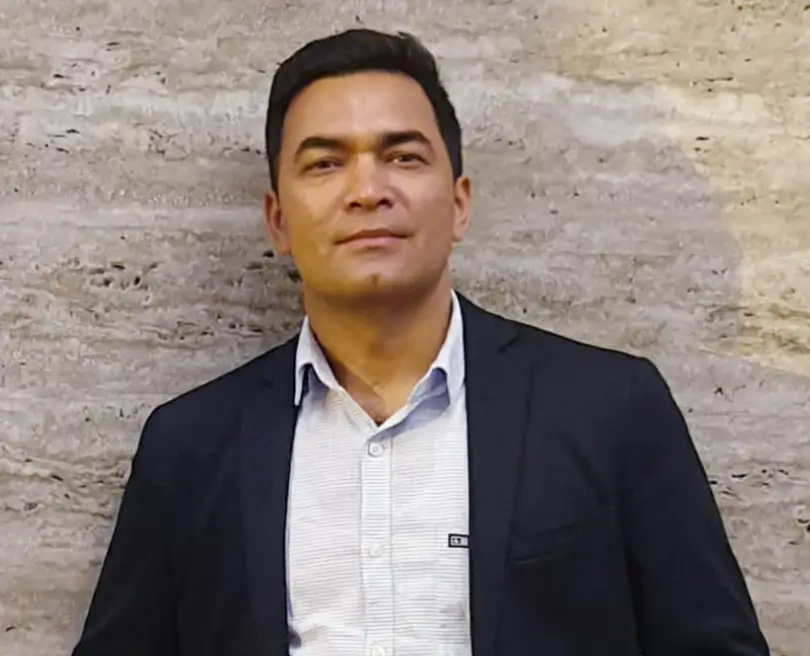
Ram Kumar Adhikari
Manager/Owner
Sangita Adhikari
Management Head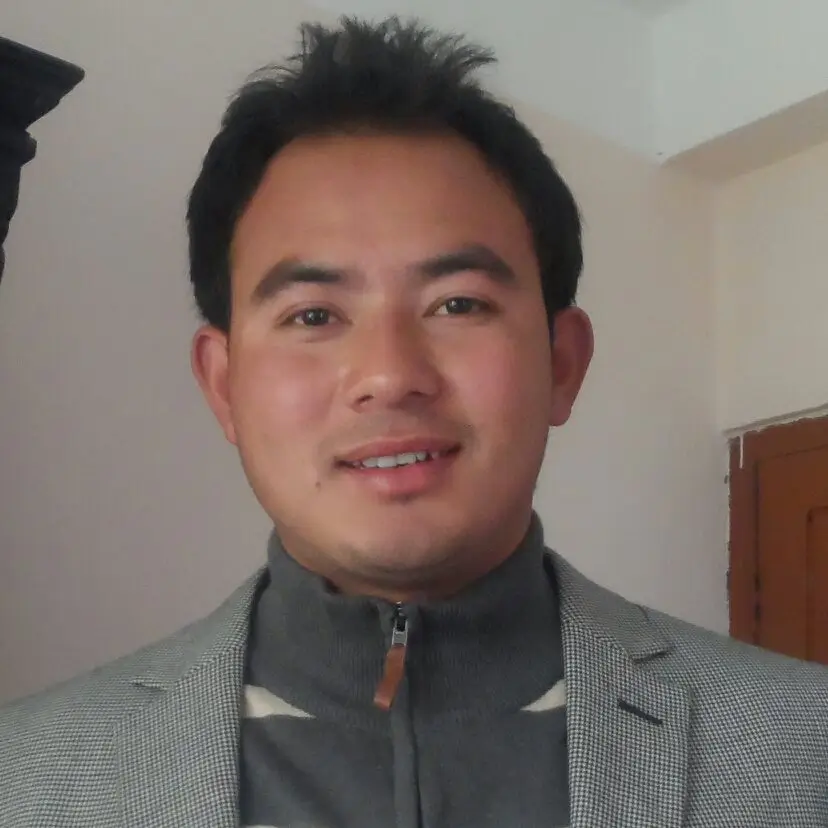
Ram Gopal Adhikari
Trip Co-ordinatorTrip Advisor Recognations
Our goal at Alpine Eco Trek is to deliver the most unforgettable and epic journeys to our clients. We create memories that are to be remembered for a lifetime. Memories you can be proud of and can share with everyone around you...
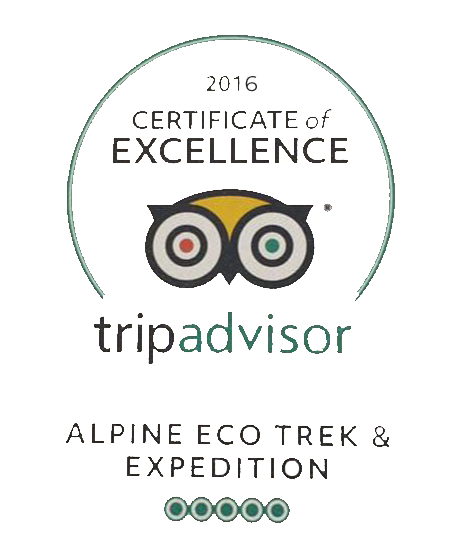
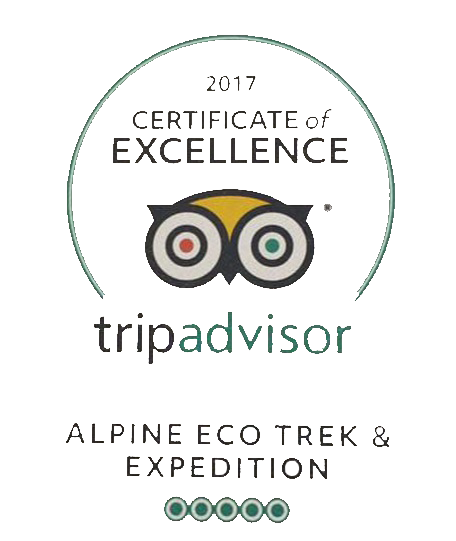
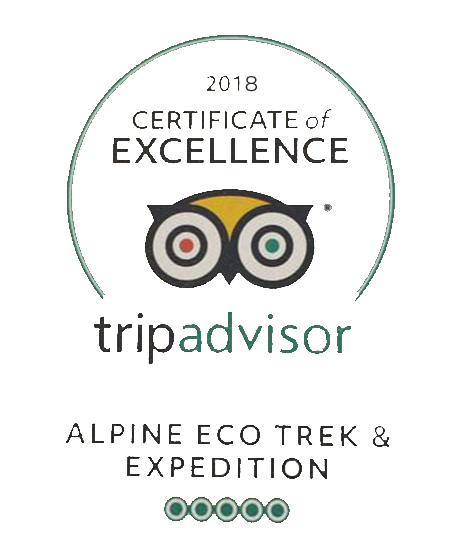
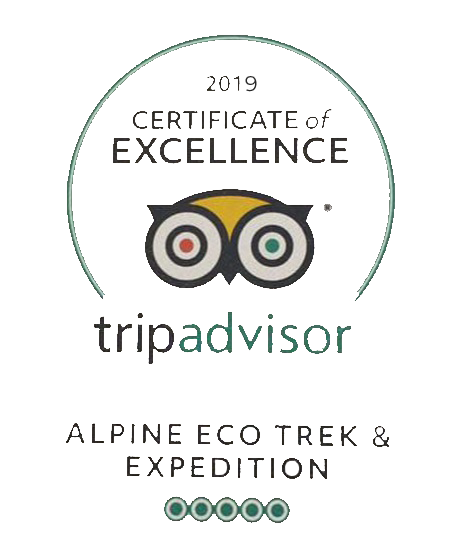
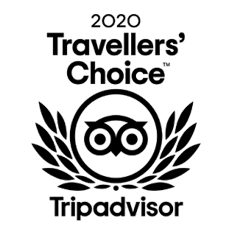

Plan Your Dream Trip with Us
Tell us your interests and travel plans, we'll design the best trip match for you.

Ram Kumar Adhikari
Manager/Owner
Sangita Adhikari
Management Head
Ram Gopal Adhikari
Trip Co-ordinatorNeed a Reference ?
Subscribe to our newsletter
Subscribe to receive the latest adventure travel updates
